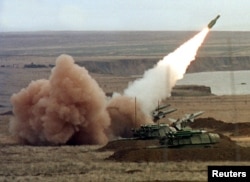A few days before the July 2014 missile attack on Malaysian Airlines flight MH17, a Ukraine Army-operated Buk missile launcher was located not near fighting in the east, as Moscow has long insisted, but hundreds of kilometers to the west.
That's what a team of journalists and researchers at Bellingcat, a Britain-based investigative website, has concluded after lengthy analysis of digital images taken by a Ukrainian army chaplain.
Bellingcat, which specializes in using open-source information such as social media posts to analyze conflicts, was one of the first groups to produce evidence debunking key elements of the Russian government's claim that Ukrainian forces shot down MH17 on July 17, 2014, killing all 298 people aboard. Bellingcat's conclusion — that Moscow doctored images in order to buttress allegations that Kyiv was responsible for the single worst atrocity of the war — was later corroborated by arms control researchers at the Middlebury Institute for International Studies at Monterey in California.
Bellingcat's new report says metadata from a series of digital images prove that the exact same Buk missile launcher that Moscow claims was within striking range of MH17 on the day of the attack was actually stationed at Mirgorod Air Base in Poltava, central Ukraine — well outside of firing distance.
"The only operational Buk missile launcher observed within firing range of MH17 on July 17, 2014, was the Russian Buk 332, from the Kursk-based 53rd Anti-Aircraft Missile Brigade," a surface-to-air combat unit of the Russian ground forces that was stationed in eastern Ukraine at the time, Bellingcat reported.
Kyiv-based political scientist Yuri Lesnichiy of the Institute of Analysis and Forecasting says the new information will prove vital to undercutting the Kremlin narrative surrounding the tragedy.
"Such high-profile investigations ... carry across particular information and the Kremlin finds it difficult to twist the facts that the Europeans will believe in," he told VOA's Russian Service.
Immediately after MH17 was shot out of clear blue skies over the frontlines in eastern Ukraine, Russia's RIA state news agency reported that Russian-backed separatists had successfully shot down a Ukrainian military aircraft. They retracted the story upon learning that it was a civilian airliner that had been brought down.
In March, Ukraine asked the United Nations' highest court to order Russia to stop funding and equipping pro-Russian separatists. In that filing, they cited a September 2016 six-country investigation team led by the Netherlands, which said MH17 had been shot down with a Russian-manufactured Buk surface-to-air missile from an area controlled by pro-Russian forces.
Russia denies sending troops or military equipment to eastern Ukraine and has dismissed findings of the September 2016 probe as biased and politically motivated.
This report was translated by Svetlana Cunningham and produced in collaboration with VOA's Russian Service.








